
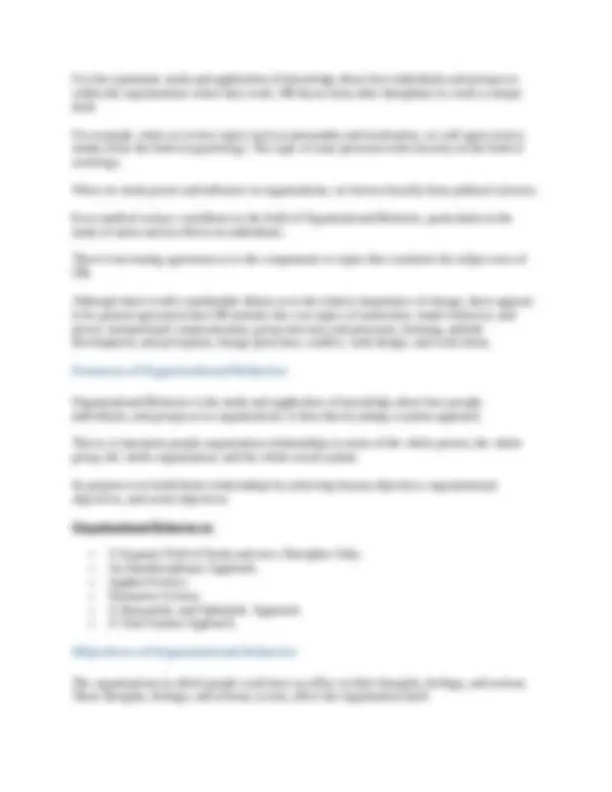
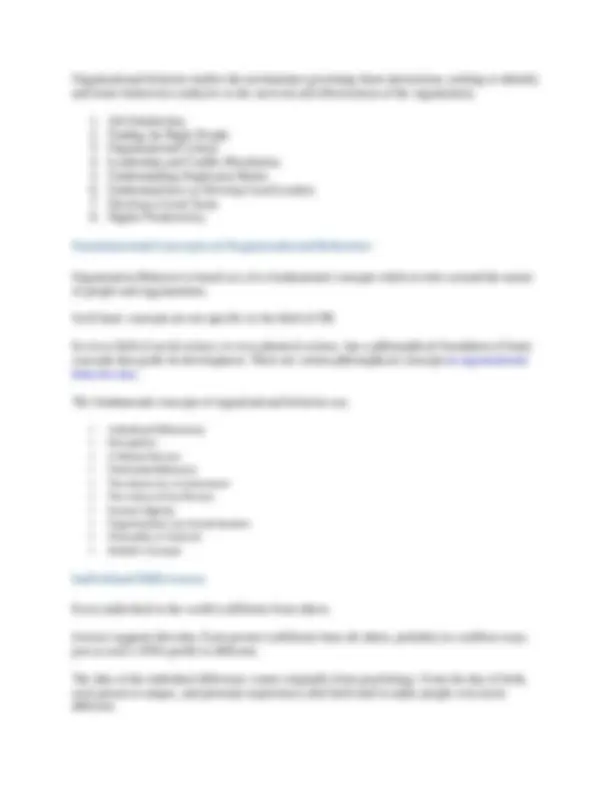
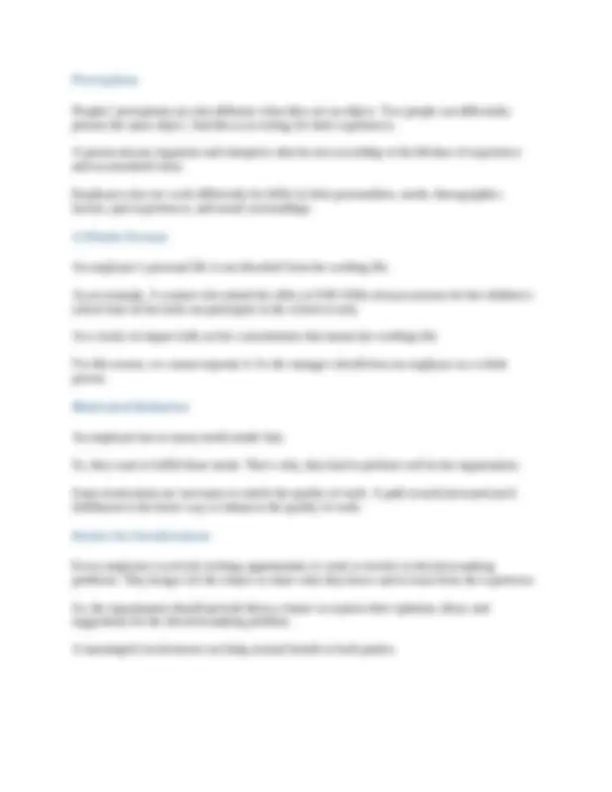
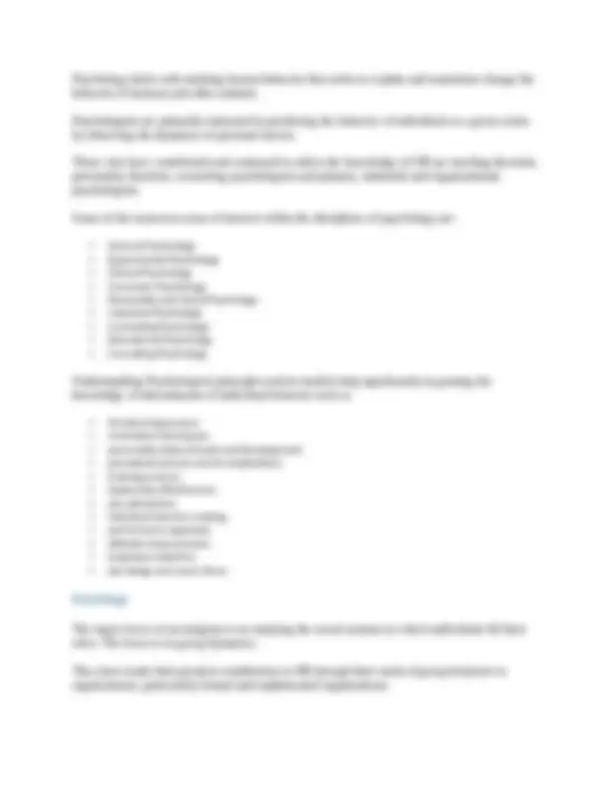
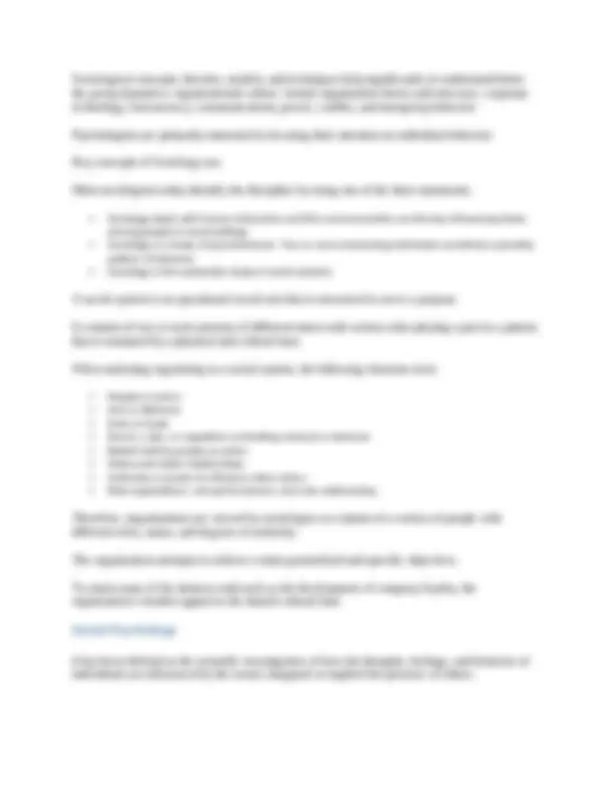
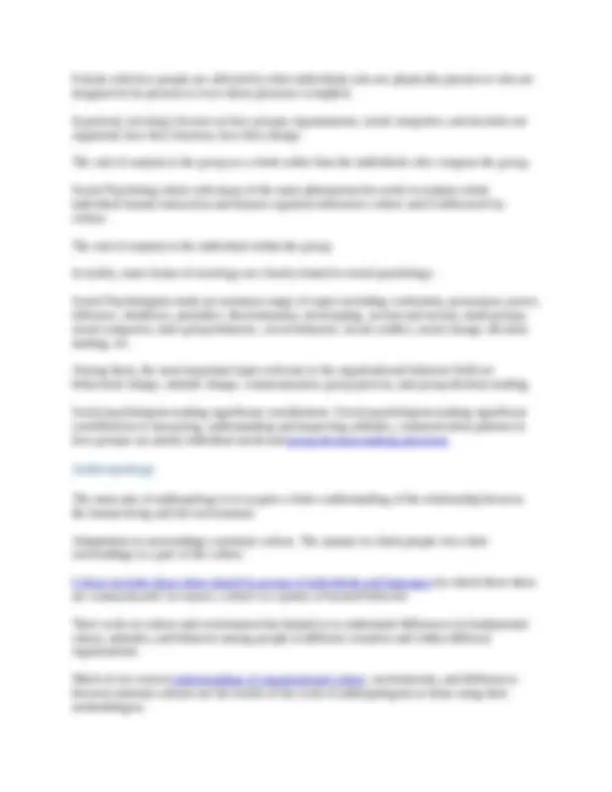
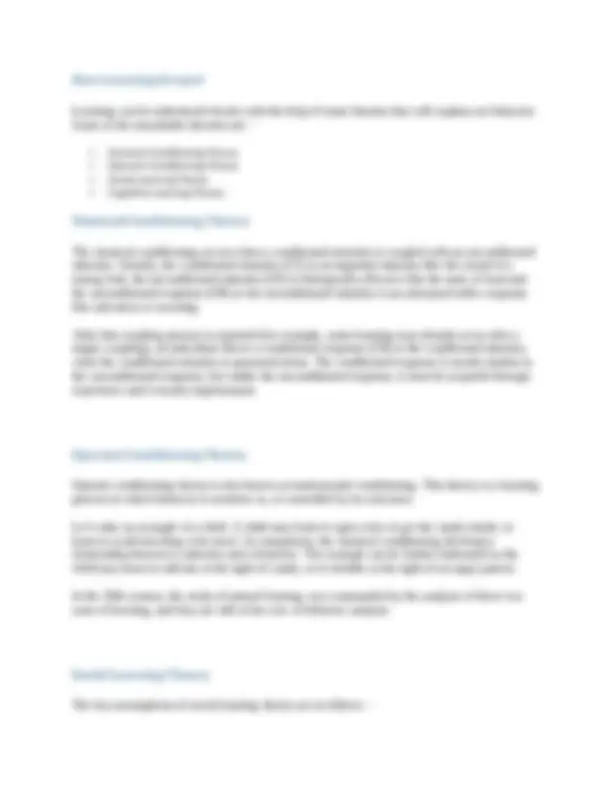
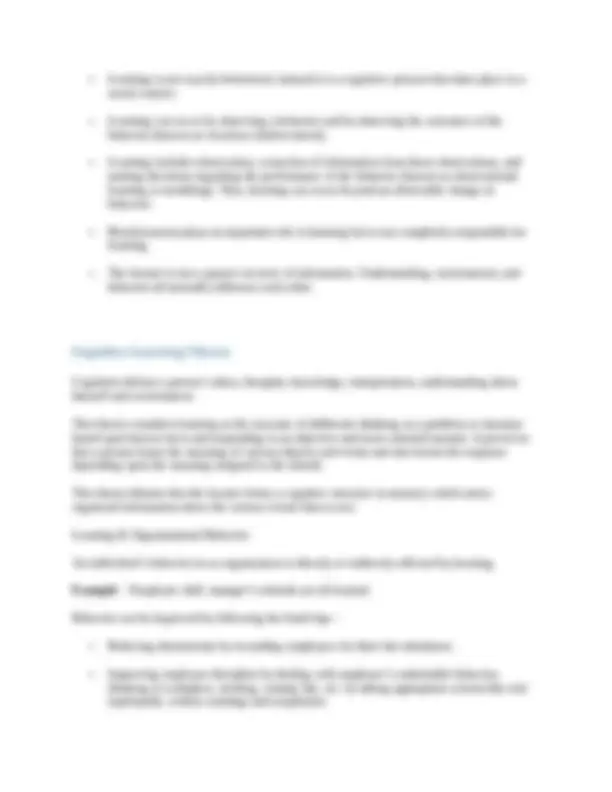
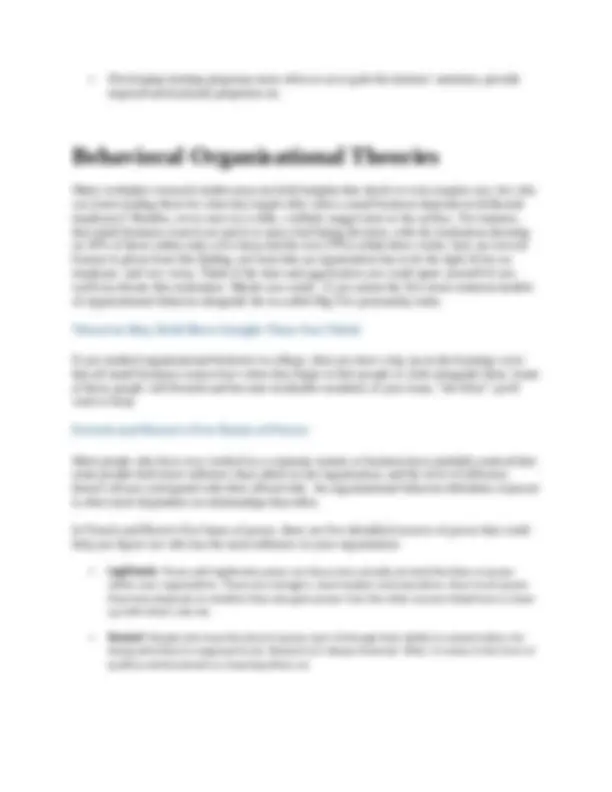


Study with the several resources on Docsity

Earn points by helping other students or get them with a premium plan


Prepare for your exams
Study with the several resources on Docsity

Earn points to download
Earn points by helping other students or get them with a premium plan
Community
Ask the community for help and clear up your study doubts
Discover the best universities in your country according to Docsity users
Free resources
Download our free guides on studying techniques, anxiety management strategies, and thesis advice from Docsity tutors
Organizational Behavior (OB) is the study of human behavior in organizational settings, the interface between human behavior and the organization, and the organization itself. Organizational Behavior researchers study the behavior of individuals primarily in their organizational roles. One of the main goals of organizational behavior is to revitalize organizational theory and develop a better conceptualization of organizational life.
Typology: Study notes
1 / 17

This page cannot be seen from the preview
Don't miss anything!










Organizational Behavior (OB) is the study of human behavior in organizational settings, the interface between human behavior and the organization, and the organization itself. Organizational Behavior researchers study the behavior of individuals primarily in their organizational roles. One of the main goals of organizational behavior is to revitalize organizational theory and develop a better conceptualization of organizational life. As a multidisciplinary field, organizational behavior has been influenced by developments in a number of allied disciplines including sociology, psychology, economics, and engineering as well as by the experience of practitioners.
Origin of Organisational Behaviour can trace its roots back to Max Weber and earlier organizational studies. The Industrial Revolution is the period from approximately 1760 when new technologies resulted in the adoption of new manufacturing techniques, including increased mechanization. The industrial revolution led to significant social and cultural change, including new forms of organization. Analyzing these new organizational forms, sociologist Max Weber described bureaucracy as an ideal type of organization that rested on rational-legal principles and maximized technical efficiency.
In the 1890’s; with the arrival of scientific management and Taylorism, Organizational Behavior Studies was forming it as an academic discipline. Failure of scientific management gave birth to the human relations movement which is characterized by a heavy emphasis on employee cooperation and morale. Human Relations Movement from the 1930’s to 1950’s contributed to shaping the Organizational Behavior studies. Works of scholars like Elton Mayo, Chester Barnard, Henri Fayol, Mary Parker Follett, Frederick Herzberg, Abraham Mas low, David Mc Cellan and Victor Vroom contributed to the growth of Organisational Behaviour as a discipline. Works of scholars like Elton Mayo, Chester Barnard, Henri Fayol, Mary Parker Follett, Frederick Herzberg, Abraham Maslow, David Mc Cellan and Victor Vroom contributed to the growth of Organisational Behaviour as a discipline. Herbert Simon’s Administrative Behavior introduced a number of important concepts to the study of organizational behavior, most notably decision making. Simon along with Chester Barnard; argued that people make decisions differently in organizations than outside of them. Simon was awarded the Nobel Prize in Economics for his work on organizational decision making. In the 1960s and 1970s, the field became more quantitative and produced such ideas as the informal organization, and resource dependence. Contingency theory, institutional theory, and organizational ecology also enraged. Starting in the 1980s, cultural explanations of organizations and organizational change became areas of study. Informed by anthropology, psychology, and sociology, qualitative research became more acceptable in OB.
Organizational behavior is directly concerned with the understanding, prediction, and control of human behavior in organizations.” — Fred Luthans. Organizational behavior is the study of both group and individual performance and activity within an organization. This area of study examines human behavior in a work environment and determines its impact on job structure, performance, communication, motivation, leadership, etc.
Organizational behavior studies the mechanisms governing these interactions, seeking to identify and foster behaviors conducive to the survival and effectiveness of the organization.
Organization Behavior is based on a few fundamental concepts which revolve around the nature of people and organizations. Such basic concepts are not specific to the field of OB. In every field of social science or even physical science, has a philosophical foundation of basic concepts that guide its development. There are certain philosophical concepts in organizational behavior also. The fundamental concepts of organizational behavior are; Individual Differences. Perception. A Whole Person. Motivated Behavior. The desire for Involvement. The value of the Person. Human Dignity. Organizations are Social System. Mutuality of Interest. Holistic Concept.
Every individual in the world is different from others. Science supports this idea. Each person is different from all others, probably in a million ways, just as each’s DNA profile is different. The idea of the individual difference comes originally from psychology. From the day of birth, each person is unique, and personal experiences after birth tend to make people even more different.
Peoples’ perceptions are also different when they see an object. Two people can differently present the same object. And this is occurring for their experiences. A person always organizes and interprets what he sees according to his lifetime of experience and accumulated value. Employees also see work differently for differ in their personalities, needs, demographics factors, past experiences, and social surroundings.
An employee’s personal life is not detached from his working life. As an example, A women who attend the office at 9:00 AM is always anxious for her children’s school time (if her kids can participate in the school or not). As a result, its impact falls on her concentration that means her working life. For this reason, we cannot separate it. So the manager should treat an employee as a whole person.
An employee has so many needs inside him. So, they want to fulfill those needs. That’s why; they had to perform well in the organization. Some motivations are necessary to enrich the quality of work. A path toward increased need fulfillment is the better way to enhances the quality of work.
Every employee is actively seeking opportunities to work to involve in decision-making problems. They hunger for the chance to share what they know and to learn from the experience. So, the organization should provide them a chance to express their opinions, ideas, and suggestions for the decision-making problem. A meaningful involvement can bring mutual benefit to both parties.
If mutuality is lacking, it makes no sense to try to assemble a group and develop cooperation, because there is no common base on which to build. Mutual interest provides a super-ordinate goal that unites the variety of needs that people bring to organizations. The result is that people are encouraged to attack organizational problems rather than each other.
When the fundamental concepts of OB are placed together, a holistic concept emerges. This concept interprets people-organization relationships regarding the whole person, the whole group, whole organization, and the whole social system. It takes across the board view of people in organizations to understand as many as possible of the factors that influence their behavior. Issues are analyzed in terms of the total situation affecting them rather than in terms of an isolated event or problems.
There are some important disciplines in the organizational behavior field which developed it extensively. Due to an increase in organizational complexity, various types of knowledge are required and help in many ways. Contributing Disciplines to the Organization Behavior Field are:
Psychology has perhaps the first influence on the field of organizational behavior because it is a science of behavior. A psychologist studies almost all aspects Of behavior.
Psychology deals with studying human behavior that seeks to explain and sometimes change the behavior of humans and other animals. Psychologists are primarily interested in predicting the behavior of individuals to a great extent by observing the dynamics of personal factors. Those who have contributed and continued to add to the knowledge of OB are teaching theorists, personality theorists, counseling psychologists and primary, industrial and organizational psychologists. Some of the numerous areas of interest within the disciplines of psychology are: General Psychology Experimental Psychology Clinical Psychology Consumer Psychology Personality and Social Psychology Industrial Psychology Counseling Psychology Educational Psychology Consulting Psychology Understanding Psychological principles and its models help significantly in gaining the knowledge of determinants of individual behavior such as the learning process, motivation techniques, personality determinants and development, perceptual process and its implications, training process, leadership effectiveness, job satisfaction, individual decision making, performance appraisal, attitude measurement, employee selection, job design and work stress.
The major focus of sociologists is on studying the social systems in which individuals fill their roles. The focus is on group dynamics. They have made their greatest contribution to OB through their study of group behavior in organizations, particularly formal and sophisticated organizations.
It deals with how people are affected by other individuals who are physically present or who are imagined to be present or even whose presence is implied. In general, sociology focuses on how groups, organizations, social categories, and societies are organized, how they function, how they change. The unit of analysis is the group as a whole rather than the individuals who compose the group. Social Psychology deals with many of the same phenomena but seeks to explain whole individual human interaction and human cognition influences culture and is influenced by culture. The unit of analysis is the individual within the group. In reality, some forms of sociology are closely related to social psychology. Social Psychologists study an enormous range of topics including conformity, persuasion, power, influence, obedience, prejudice, discrimination, stereotyping, sexism and racism, small groups, social categories, inter-group behavior, crowd behavior, social conflict, social change, decision making, etc. Among them, the most important topics relevant to the organizational behavior field are behavioral change, attitude change, communication, group process, and group decision making. Social psychologists making significant contributions. Social psychologists making significant contributions to measuring, understanding and improving attitudes, communication patterns in how groups can satisfy individual needs and group decision-making processes.
The main aim of anthropology is to acquire a better understanding of the relationship between the human being and the environment. Adaptations to surroundings constitute culture. The manner in which people view their surroundings is a part of the culture. Culture includes those ideas shared by groups of individuals and languages by which these ideas are communicated. In essence, culture is a system of learned behavior. Their work on culture and environment has helped us to understand differences in fundamental values, attitudes, and behavior among people in different countries and within different organizations. Much of our current understandings of organizational culture, environments, and differences between national cultures are the results of the work of anthropologists or those using their methodologies.
The world is the laboratory of anthropologists, and human beings must be studied in the natural habitat. Understanding the importance of studying man in natural settings over time enables one to grasp the range of anthropology. Familiarity within some of the cultural differences of employees can lead to greater managerial objectivity and depth in the interpretation of behavior and performance. Anthropologists contribute to study some aspects of organizational settings – similar values, comparative attitudes, cross-cultural analysis between or among the employees.
Contributions of political scientists are significant to the understanding of behavior in organizations. Political scientists study the behavior of individuals and groups within a political environment. They contribute to understanding the dynamics of power centers, structuring of conflict and conflict resolution tactics, allocation of power and how people manipulate power for individual self-interest. In a business field, organizations wanted to attain supremacy in their field and indulge in politicking activities to gain maximum advantages by following certain tasks like Machiavellianism, coalition formation, malpractices, etc. The knowledge of political science can be utilized in the study the behavior of employees, executives at micro as well as macro level.
Economics contributes to organizational behavior to a great extent in designing the organizational structure. Transaction cost economics influence the organization and its structure. Transaction costs economics implies cost components to make an exchange on the market. This transaction cost economics examines the extent to which the organization structure and size of an organization varies in response to attempts to avoid market failures through minimizing production and transaction costs within the constraints of human and environmental factors. Costs of transactions include both costs of market transactions and internal coordination. A transaction occurs when a good or service is transferred across a ‘technologically separable barrier’ Transaction costs arise for many reasons. So we can assume that there are various types of disciplines that involve organizational behavior. They, directly and indirectly, influence the overall activities of OB.
Learning can be understood clearly with the help of some theories that will explain our behavior. Some of the remarkable theories are − Classical Conditioning Theory Operant Conditioning Theory Social Learning Theory Cognitive Learning Theory
The classical conditioning occurs when a conditioned stimulus is coupled with an unconditioned stimulus. Usually, the conditioned stimulus (CS) is an impartial stimulus like the sound of a tuning fork, the unconditioned stimulus (US) is biologically effective like the taste of food and the unconditioned response (UR) to the unconditioned stimulus is an unlearned reflex response like salivation or sweating. After this coupling process is repeated (for example, some learning may already occur after a single coupling), an individual shows a conditioned response (CR) to the conditioned stimulus, when the conditioned stimulus is presented alone. The conditioned response is mostly similar to the unconditioned response, but unlike the unconditioned response, it must be acquired through experience and is nearly impermanent.
Operant conditioning theory is also known as instrumental conditioning. This theory is a learning process in which behavior is sensitive to, or controlled by its outcomes. Let’s take an example of a child. A child may learn to open a box to get the candy inside, or learn to avoid touching a hot stove. In comparison, the classical conditioning develops a relationship between a stimulus and a behavior. The example can be further elaborated as the child may learn to salivate at the sight of candy, or to tremble at the sight of an angry parent. In the 20th century, the study of animal learning was commanded by the analysis of these two sorts of learning, and they are still at the core of behavior analysis.
The key assumptions of social learning theory are as follows −
Learning is not exactly behavioral, instead it is a cognitive process that takes place in a social context. Learning can occur by observing a behavior and by observing the outcomes of the behavior (known as vicarious reinforcement). Learning includes observation, extraction of information from those observations, and making decisions regarding the performance of the behavior (known as observational learning or modeling). Thus, learning can occur beyond an observable change in behavior. Reinforcement plays an important role in learning but is not completely responsible for learning. The learner is not a passive receiver of information. Understanding, environment, and behavior all mutually influence each other.
Cognition defines a person’s ideas, thoughts, knowledge, interpretation, understanding about himself and environment. This theory considers learning as the outcome of deliberate thinking on a problem or situation based upon known facts and responding in an objective and more oriented manner. It perceives that a person learns the meaning of various objects and events and also learns the response depending upon the meaning assigned to the stimuli. This theory debates that the learner forms a cognitive structure in memory which stores organized information about the various events that occurs. Learning & Organizational Behavior An individual’s behavior in an organization is directly or indirectly affected by learning. Example − Employee skill, manager’s attitude are all learned. Behavior can be improved by following the listed tips − Reducing absenteeism by rewarding employees for their fair attendance. Improving employee discipline by dealing with employee’s undesirable behavior, drinking at workplace, stealing, coming late, etc. by taking appropriate actions like oral reprimands, written warnings and suspension.
Expert: Most professional settings have someone in the mix who's famous for being incredibly knowledgeable and skilled at what they do. When others need information, they go to the expert who helps them learn what they need to know in order to succeed. Referent: Referent power comes through the ability to relate with others and practice incredible relational skills in the workplace. These individuals are well liked and respected because of who they are, their personality and their ability to unify people across their differences. Coercive: People who have coercive power tend to be the company manipulators who don't always have the best people skills. In contrast to those who have power through reward, these characters accumulate power through emotional punishment of others. These are generally not the healthiest people to team up with in your leadership, although awareness of them is important to managing them so they don't stand in the way of those who hold more positive and helpful forms of power.
Hybrid organization theory argues that people no longer have to choose between being an altruistic nonprofit or being a for-profit enterprise. In the organizational behavior definition of a hybrid organization, a company can be both altruistic and make a profit, as can teams and individuals within an organization. This model for organizational development and behavior is becoming more common with companies like Toms, Sevenly and Pura Vida paving the way. Even if your company isn't an official hybrid organization, you can include these principles into the strategies you employ for managing your team. Consider organizing a team effort to make a difference for homelessness, human trafficking or another cause. As you reach certain team goals, your reward can be the opportunity to give back together.
Of all the organizational theories, the informal theory is the one that best recognizes that there are often hidden systems within formal company structures. These informal organizations are the friendships and relationships formed between people in the organization. Suzy in accounting might eat lunch with Joe the CEO and become best buddies with Erica in the legal department. The three of them end up going on vacation together or enjoying weekend fun. This is an informal organization within the company. If Suzy has a legal question about accounting, Erica is likely to help her out and Joe will probably back up whatever decisions the two of them make together. As a business leader, it's important to take note of friendships and other alliances that form within your organization. These informal alliances can help you to better achieve your goals. They can also stand in the way of them when they're not healthy.
Most product-based industries are well acquainted with the resource dependence theory. This theory states that performance is often influenced by the availability of outside resources. For instance, the toy manufacturer relies on toy wheels from China to manufacture its toy cars. This can even be an issue in service professions like when quality internet signals determine whether or not a life coach can meet with clients on Zoom. Some organizational behavior professionals also consider customers to be a resource. Without customers, your business can't thrive, so to ensure you're thriving, it's vital to maintain several streams for acquiring and retaining customers. When there are multiple sources available for attaining the resources needed for a business to thrive, this creates the security necessary for the people within the system to thrive.
No matter what organizational behavior theories you subscribe to, it's important to lead your team intentionally with focus and heart. If you find that one theory isn't helpful in your setting or isn't producing results, look into incorporating multiple theories into your leadership approach. For instance, some of the best managers recognize that there are internal systems (informal organization theory), outside influences (resource dependence theory), differing sources of power (French and Raven's five bases of power), ways to make a social difference (hybrid organization theory) and that things are always in flux (complexity theory).
When attempting to use more than one theory of organizational behavior and understand how the complex systems in your business work, one of the most helpful tools could be Mintzberg's organigraph. Unlike organizational diagrams that only picture the hierarchical structure of the company, an organigraph also shows relationships, dynamics and patterns of communication between departments, teams, individuals and even outside suppliers. In other words, instead of drawing the company's structure, when you create an organigraph you show how it actually works. For instance, in the engineering department of a telecommunications company, an organigraph would use hubs and webs to show how planning engineers interact with field engineers, upper management, customers and even that they go out to lunch with suppliers. If someone from the sales department wants information on suppliers, this organigraph would show them that the best person to call would be a planning engineer. A traditional organizational chart wouldn't show any of this.